2002 Hyundai Grandeur tow
[x] Cancel search: towPage 1 of 230

NAME: STREET:TOWN: COUNTRY: P.CODE: NAME: STREET: TOWN:COUNTRY: P.CODE:
A000A01A-GAT This Owner's Manual should be considered a part of the car and remain with it when it is sold for the use of the next owner.OWNER'S I.D.
ORIGINAL: ADDRESS: DATE OF SALE: SUBSEQUENT: ADDRESS: TRANSFER DATE:
Page 16 of 230
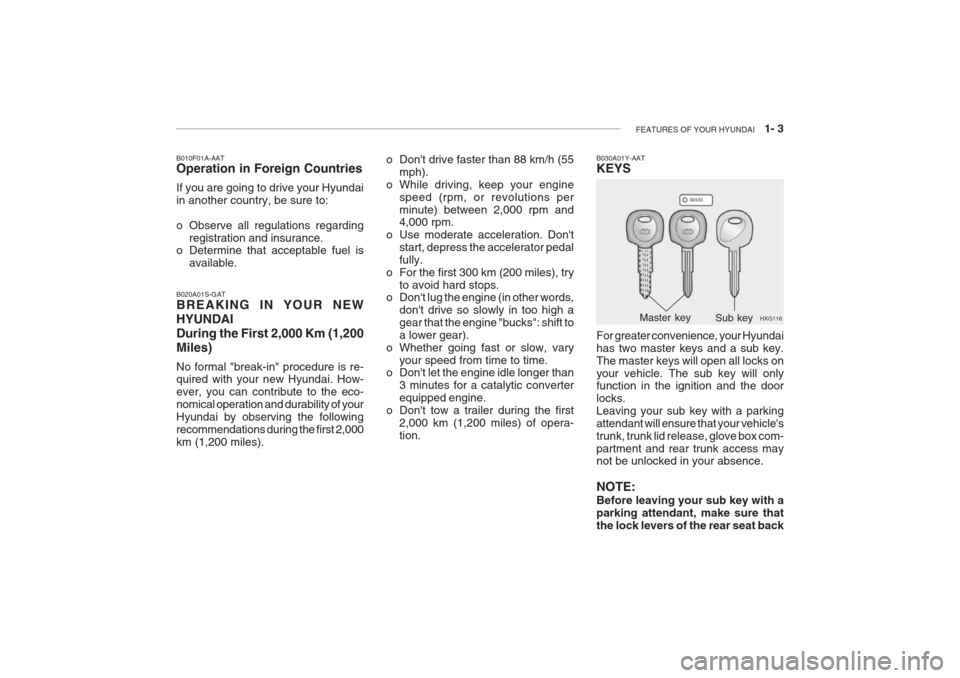
FEATURES OF YOUR HYUNDAI 1- 3
B010F01A-AAT Operation in Foreign Countries If you are going to drive your Hyundai in another country, be sure to:
o Observe all regulations regarding
registration and insurance.
o Determine that acceptable fuel is
available.
B020A01S-GAT BREAKING IN YOUR NEW HYUNDAIDuring the First 2,000 Km (1,200Miles) No formal "break-in" procedure is re- quired with your new Hyundai. How- ever, you can contribute to the eco-nomical operation and durability of yourHyundai by observing the followingrecommendations during the first 2,000km (1,200 miles). B030A01Y-AAT KEYS For greater convenience, your Hyundai has two master keys and a sub key.The master keys will open all locks onyour vehicle. The sub key will only function in the ignition and the door locks.Leaving your sub key with a parkingattendant will ensure that your vehicle'strunk, trunk lid release, glove box com-partment and rear trunk access may not be unlocked in your absence. NOTE: Before leaving your sub key with a parking attendant, make sure thatthe lock levers of the rear seat back
HXG116
Master key Sub key
o Don't drive faster than 88 km/h (55
mph).
o While driving, keep your engine speed (rpm, or revolutions per minute) between 2,000 rpm and 4,000 rpm.
o Use moderate acceleration. Don't start, depress the accelerator pedal fully.
o For the first 300 km (200 miles), try to avoid hard stops.
o Don't lug the engine (in other words,
don't drive so slowly in too high agear that the engine "bucks": shift toa lower gear).
o Whether going fast or slow, vary
your speed from time to time.
o Don't let the engine idle longer than
3 minutes for a catalytic converterequipped engine.
o Don't tow a trailer during the first 2,000 km (1,200 miles) of opera-tion.
Page 19 of 230
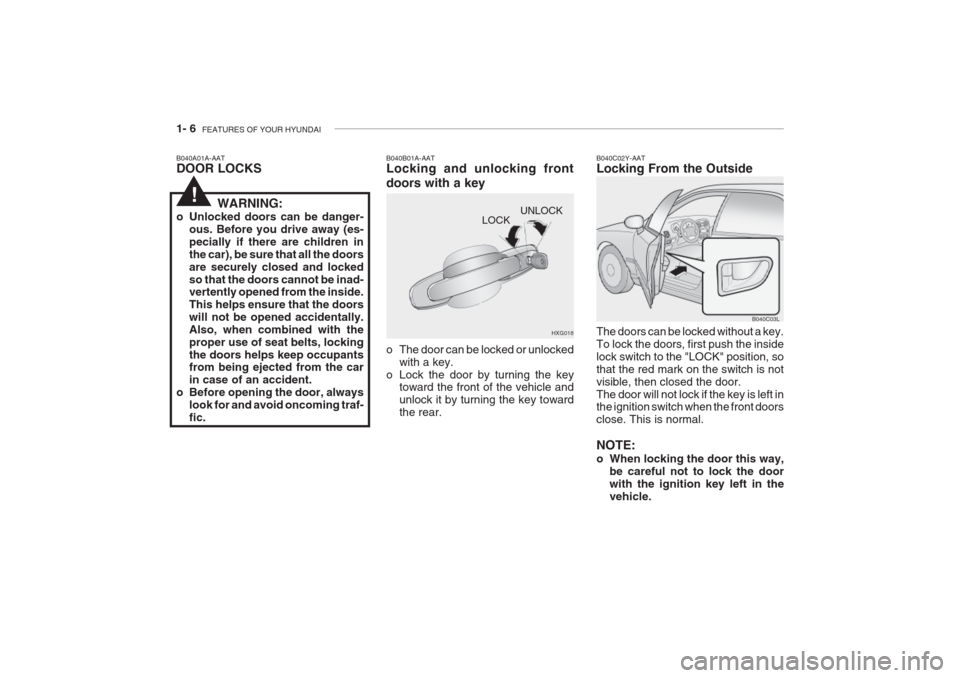
1- 6 FEATURES OF YOUR HYUNDAI
UNLOCK
LOCK
HXG018
B040A01A-AAT DOOR LOCKS
B040B01A-AATLocking and unlocking front doors with a key
o The door can be locked or unlocked
with a key.
o Lock the door by turning the key toward the front of the vehicle and unlock it by turning the key towardthe rear.
!
B040C03L
B040C02Y-AAT Locking From the Outside The doors can be locked without a key. To lock the doors, first push the insidelock switch to the "LOCK" position, sothat the red mark on the switch is notvisible, then closed the door.The door will not lock if the key is left in the ignition switch when the front doors close. This is normal. NOTE:
o When locking the door this way,
be careful not to lock the door with the ignition key left in thevehicle.
WARNING:
o Unlocked doors can be danger- ous. Before you drive away (es-pecially if there are children inthe car), be sure that all the doorsare securely closed and lockedso that the doors cannot be inad- vertently opened from the inside. This helps ensure that the doorswill not be opened accidentally.Also, when combined with theproper use of seat belts, lockingthe doors helps keep occupants from being ejected from the car in case of an accident.
o Before opening the door, always
look for and avoid oncoming traf-fic.
Page 25 of 230
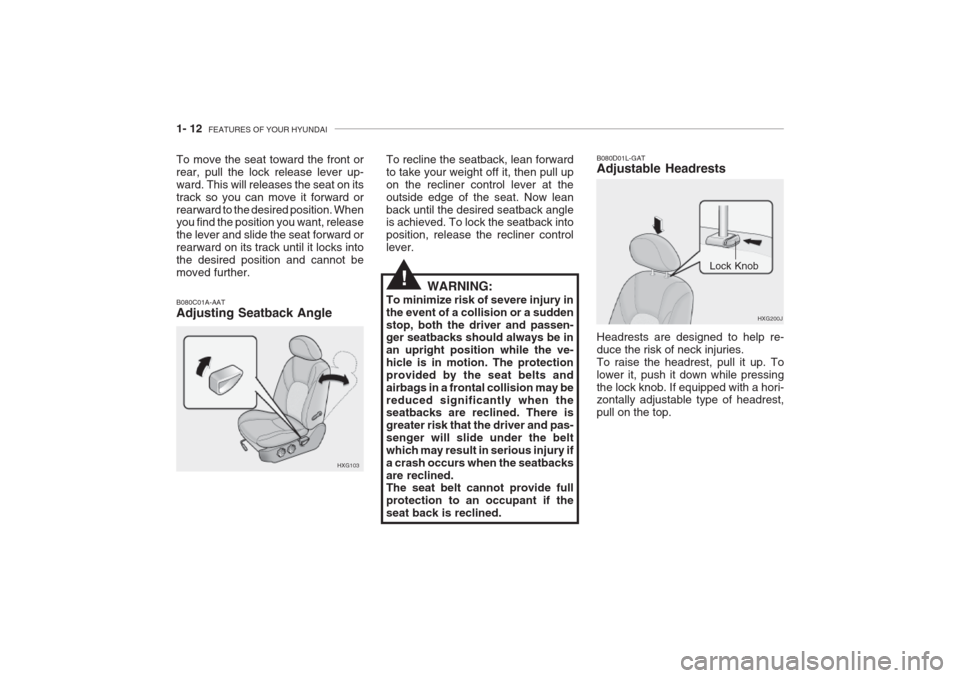
1- 12 FEATURES OF YOUR HYUNDAI
To move the seat toward the front or rear, pull the lock release lever up-ward. This will releases the seat on itstrack so you can move it forward orrearward to the desired position. When you find the position you want, release the lever and slide the seat forward orrearward on its track until it locks intothe desired position and cannot bemoved further.
HXG103
B080C01A-AAT Adjusting Seatback Angle
To recline the seatback, lean forward to take your weight off it, then pull upon the recliner control lever at theoutside edge of the seat. Now leanback until the desired seatback angle is achieved. To lock the seatback into position, release the recliner controllever.
WARNING:
To minimize risk of severe injury inthe event of a collision or a suddenstop, both the driver and passen- ger seatbacks should always be in an upright position while the ve-hicle is in motion. The protectionprovided by the seat belts andairbags in a frontal collision may bereduced significantly when the seatbacks are reclined. There is greater risk that the driver and pas-senger will slide under the beltwhich may result in serious injury ifa crash occurs when the seatbacksare reclined. The seat belt cannot provide full protection to an occupant if theseat back is reclined.
!
HXG200J
Lock Knob
B080D01L-GAT Adjustable Headrests Headrests are designed to help re- duce the risk of neck injuries.To raise the headrest, pull it up. Tolower it, push it down while pressingthe lock knob. If equipped with a hori- zontally adjustable type of headrest, pull on the top.
Page 26 of 230
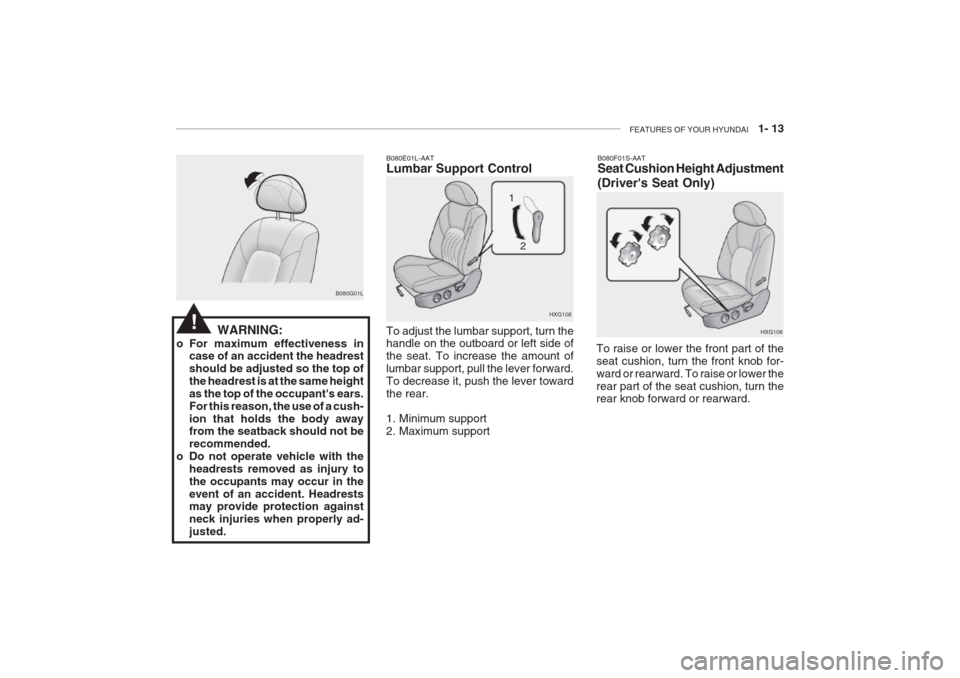
FEATURES OF YOUR HYUNDAI 1- 13
B080F01S-AAT Seat Cushion Height Adjustment (Driver's Seat Only)
To raise or lower the front part of the seat cushion, turn the front knob for-ward or rearward. To raise or lower therear part of the seat cushion, turn the rear knob forward or rearward. HXG106B080E01L-AAT Lumbar Support Control To adjust the lumbar support, turn the handle on the outboard or left side of the seat. To increase the amount oflumbar support, pull the lever forward.To decrease it, push the lever towardthe rear.
1. Minimum support
2. Maximum supportHXG108
2
1
B080G01L
WARNING:
o For maximum effectiveness in case of an accident the headrestshould be adjusted so the top ofthe headrest is at the same heightas the top of the occupant's ears.For this reason, the use of a cush-ion that holds the body away from the seatback should not be recommended.
o Do not operate vehicle with the headrests removed as injury tothe occupants may occur in theevent of an accident. Headrests may provide protection against neck injuries when properly ad-justed.
!
Page 38 of 230
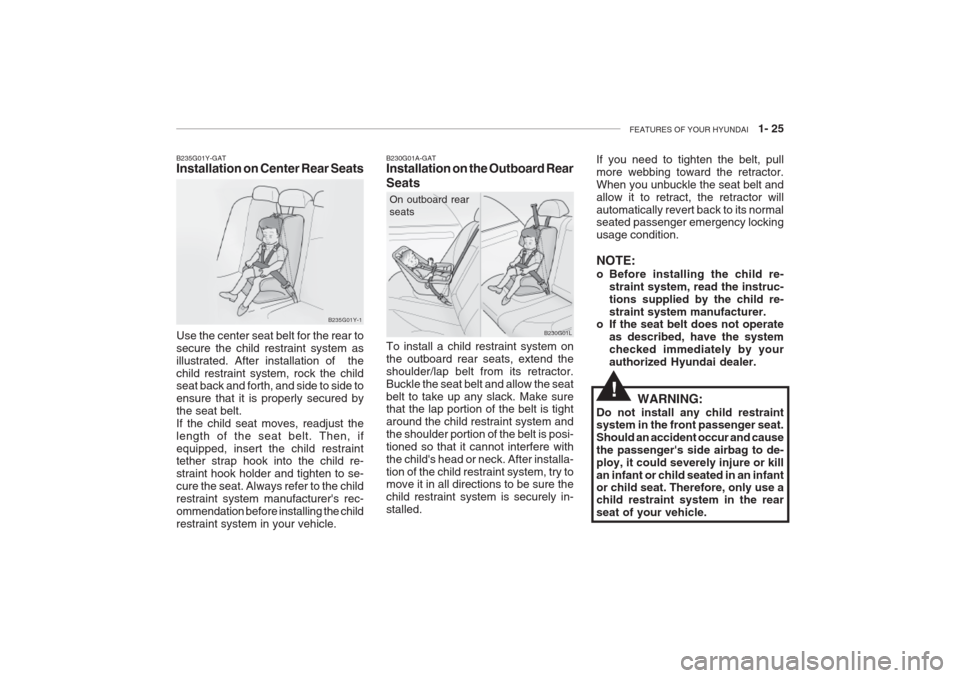
FEATURES OF YOUR HYUNDAI 1- 25
B235G01Y-GAT Installation on Center Rear Seats
B235G01Y-1
Use the center seat belt for the rear to secure the child restraint system asillustrated. After installation of thechild restraint system, rock the child seat back and forth, and side to side to ensure that it is properly secured bythe seat belt.If the child seat moves, readjust thelength of the seat belt. Then, ifequipped, insert the child restraint tether strap hook into the child re- straint hook holder and tighten to se-cure the seat. Always refer to the childrestraint system manufacturer's rec-ommendation before installing the childrestraint system in your vehicle.
On outboard rear seats
B230G01A-GAT Installation on the Outboard Rear Seats To install a child restraint system on the outboard rear seats, extend theshoulder/lap belt from its retractor.Buckle the seat belt and allow the seatbelt to take up any slack. Make sure that the lap portion of the belt is tight around the child restraint system andthe shoulder portion of the belt is posi-tioned so that it cannot interfere withthe child's head or neck. After installa-tion of the child restraint system, try to move it in all directions to be sure the child restraint system is securely in-stalled. B230G01L
If you need to tighten the belt, pullmore webbing toward the retractor.When you unbuckle the seat belt andallow it to retract, the retractor willautomatically revert back to its normal seated passenger emergency locking usage condition. NOTE:
o Before installing the child re-
straint system, read the instruc- tions supplied by the child re-straint system manufacturer.
o If the seat belt does not operate
as described, have the systemchecked immediately by yourauthorized Hyundai dealer.
WARNING:
Do not install any child restraint system in the front passenger seat. Should an accident occur and causethe passenger's side airbag to de-ploy, it could severely injure or killan infant or child seated in an infantor child seat. Therefore, only use a child restraint system in the rear seat of your vehicle.
!
Page 51 of 230
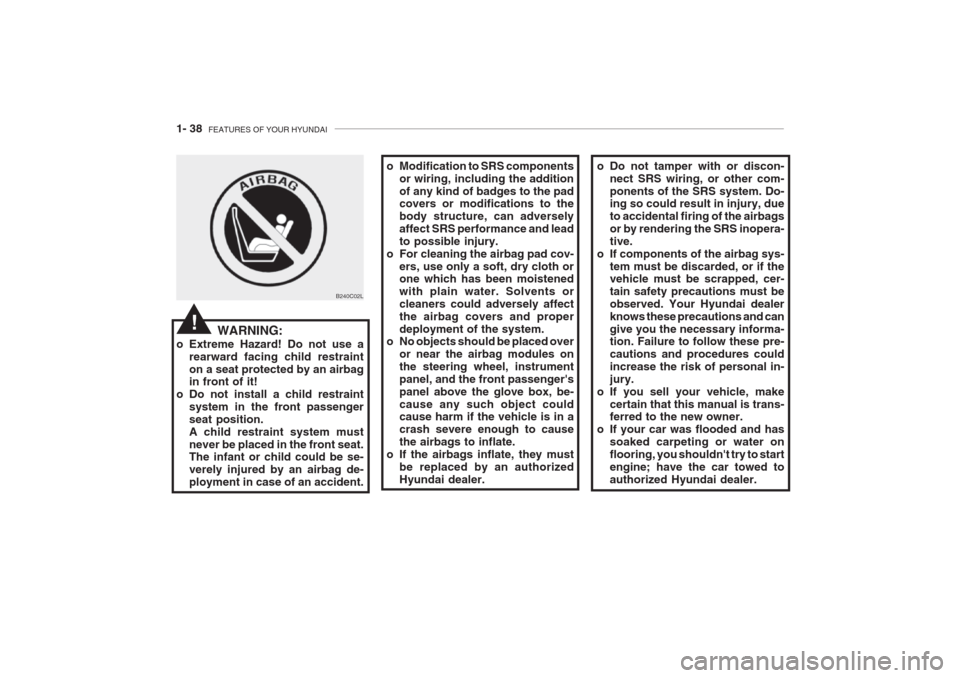
1- 38 FEATURES OF YOUR HYUNDAI
o Modification to SRS components
or wiring, including the addition of any kind of badges to the pad covers or modifications to the body structure, can adverselyaffect SRS performance and leadto possible injury.
o For cleaning the airbag pad cov- ers, use only a soft, dry cloth or one which has been moistened with plain water. Solvents orcleaners could adversely affectthe airbag covers and properdeployment of the system.
o No objects should be placed over
or near the airbag modules onthe steering wheel, instrumentpanel, and the front passenger'spanel above the glove box, be-cause any such object could cause harm if the vehicle is in a crash severe enough to causethe airbags to inflate.
o If the airbags inflate, they must be replaced by an authorizedHyundai dealer. o Do not tamper with or discon-
nect SRS wiring, or other com-ponents of the SRS system. Do- ing so could result in injury, due to accidental firing of the airbagsor by rendering the SRS inopera-tive.
o If components of the airbag sys- tem must be discarded, or if the vehicle must be scrapped, cer- tain safety precautions must beobserved. Your Hyundai dealerknows these precautions and cangive you the necessary informa- tion. Failure to follow these pre- cautions and procedures couldincrease the risk of personal in-jury.
o If you sell your vehicle, make certain that this manual is trans- ferred to the new owner.
o If your car was flooded and has
soaked carpeting or water on flooring, you shouldn't try to startengine; have the car towed toauthorized Hyundai dealer.
B240C02L
WARNING:
o Extreme Hazard! Do not use a rearward facing child restraint on a seat protected by an airbag in front of it!
o Do not install a child restraint system in the front passenger seat position.A child restraint system mustnever be placed in the front seat. The infant or child could be se- verely injured by an airbag de-ployment in case of an accident.
!
Page 55 of 230
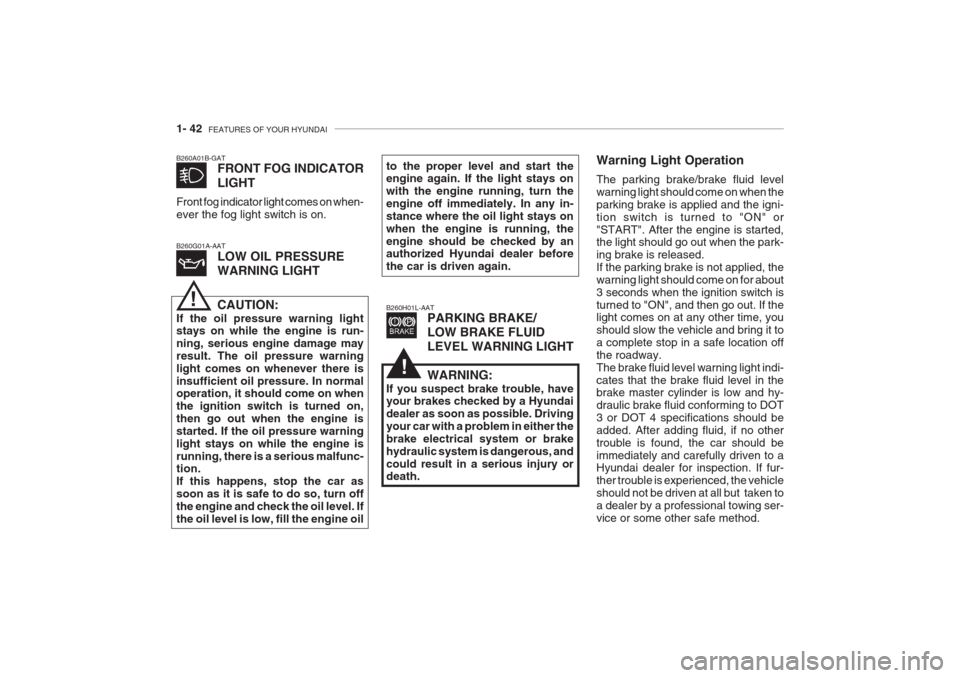
1- 42 FEATURES OF YOUR HYUNDAI
B260A01B-GAT
FRONT FOG INDICATOR LIGHT
Front fog indicator light comes on when- ever the fog light switch is on. B260G01A-AAT LOW OIL PRESSURE WARNING LIGHT CAUTION:
If the oil pressure warning light stays on while the engine is run- ning, serious engine damage mayresult. The oil pressure warninglight comes on whenever there isinsufficient oil pressure. In normal operation, it should come on when the ignition switch is turned on,then go out when the engine isstarted. If the oil pressure warninglight stays on while the engine isrunning, there is a serious malfunc- tion. If this happens, stop the car assoon as it is safe to do so, turn offthe engine and check the oil level. Ifthe oil level is low, fill the engine oil to the proper level and start the engine again. If the light stays on with the engine running, turn theengine off immediately. In any in-stance where the oil light stays onwhen the engine is running, theengine should be checked by an authorized Hyundai dealer before the car is driven again.
!B260H01L-AAT
PARKING BRAKE/ LOW BRAKE FLUID
LEVEL WARNING LIGHT
WARNING:
If you suspect brake trouble, have your brakes checked by a Hyundai dealer as soon as possible. Drivingyour car with a problem in either thebrake electrical system or brakehydraulic system is dangerous, andcould result in a serious injury or death. Warning Light Operation The parking brake/brake fluid level warning light should come on when theparking brake is applied and the igni-tion switch is turned to "ON" or"START". After the engine is started, the light should go out when the park- ing brake is released.If the parking brake is not applied, thewarning light should come on for about3 seconds when the ignition switch isturned to "ON", and then go out. If the light comes on at any other time, you should slow the vehicle and bring it toa complete stop in a safe location offthe roadway.The brake fluid level warning light indi-cates that the brake fluid level in the brake master cylinder is low and hy- draulic brake fluid conforming to DOT3 or DOT 4 specifications should beadded. After adding fluid, if no othertrouble is found, the car should beimmediately and carefully driven to a Hyundai dealer for inspection. If fur- ther trouble is experienced, the vehicleshould not be driven at all but taken toa dealer by a professional towing ser-vice or some other safe method.
!